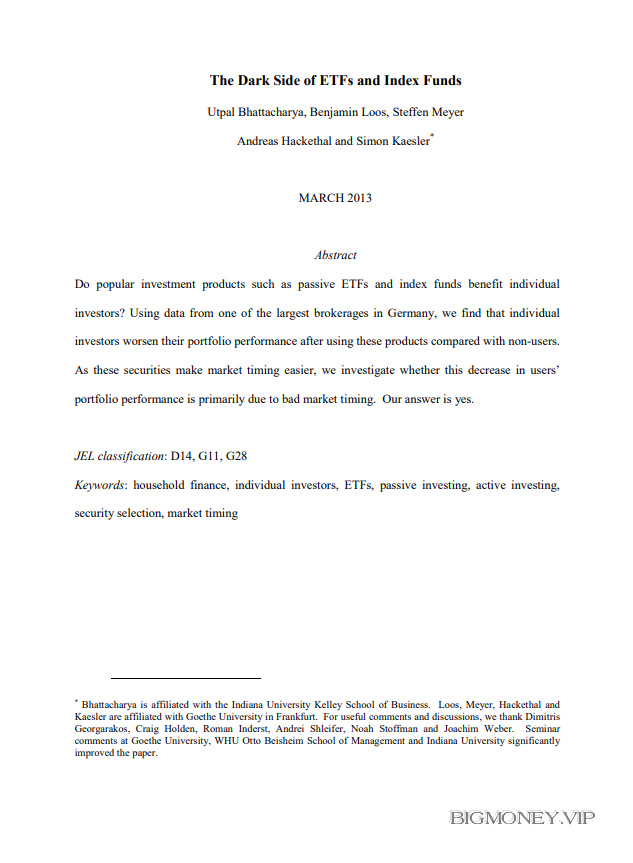The Dark Side of ETFs and Index Funds by Utpal Bhattacharya, Benjamin Loos, Steffen Meyer Andreas Hackethal and Simon Kaesler

The Dark Side of ETFs and Index Funds
Some of the most successful retail investment products of the last twenty years are index-
linked securities, namely passive Exchange Traded Funds (ETFs) and index funds.
The first
retail index mutual fund was launched in 1976 by John Bogle at Vanguard.
In 2011, in the U.S.,
383 index funds managed total net assets of $1.1 trillion. Of households that owned mutual
funds, 33% owned at least one index mutual fund.
The first ETF was launched in Canada in
1990. In 2012, there were 4,731 ETFs with $2 trillion in assets (the same size as hedge funds),
accounting for 16% of NYSE trading volume.
This paper investigates whether these index-linked securities have benefited individual
investors and, if not, why. This is an important question to answer considering how popular
these index-linked securities are becoming among individual investors. Companies are actively
seeking ways to include ETFs in 401(k) defined-contribution plans.
Even some regulators are
promoting ETFs to individual investors.
The null hypothesis is that individual investors have benefited by using index-linked
securities like ETFs. Classical finance theory supports this hypothesis. These products invest in
well-diversified security baskets, and the benefits of diversification have been formalized in
seminal papers in finance.
Boldin and Cici (2010) reviewed the entire empirical literature on
index funds and discussed the benefits of index funds. French (2008) measured the benefits of
passive investing and concluded that “the typical investor would increase his average annual
return by 67 basis points over the 1980-2006 period if he switched to a passive market portfolio.”
Benefits of diversification and passive investing may be even more pronounced for individual
investors, given that they significantly under-diversify and over-trade. The benefits may be
even higher for ETFs because ETFs offer many advantages over open-end index funds. First, the
fees of ETFs are lower compared to the funds. Second, ETFs trade in real time as opposed to
funds, whose price is determined at the end of the day. Third, ETFs may have tax advantages
(Poterba and Shoven 2002).
The alternate hypothesis is that individual investors have not benefited by using index-
linked securities like ETFs.
There is some evidence that investors may not be using these
products effectively. Hortaçsu and Syverson (2004) found large fee dispersions although the




